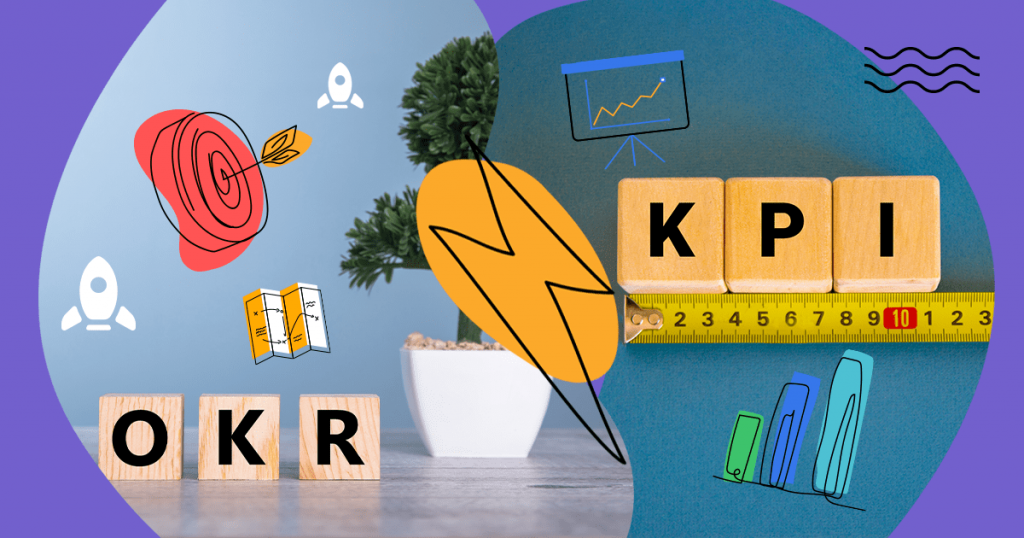Let’s face it. There are quite a few acronyms used within the digital marketing world and business as a whole that few people truly understand.
However, if you listen close enough, you’ll likely hear someone use the terms OKR and KPI.
What do these mean? Why are they important? And what is the difference between OKRs vs KPIs?
In this guide, we’ll go over what each term describes, why they’re meaningful to your organization, and how your business can use them both for better results.
Ready to get started?
- What is an OKR?
- OKR Examples
- What is a KPI?
- KPI Examples
- OKRs vs KPIs: How Are They Different?
- OKRs vs KPIs: How Can They Work Together?
- Wrap Up
What is an OKR?
The first term we’ll cover in this guide is OKR.
Objectives and Key Results (OKRs) are areas of improvement where your business can make changes. More specifically, they’re designed for goal setting.
Many companies use this as a way to essentially set the benchmarks of where they want to be quarterly or to determine steps necessary to see improved results.
Often, OKRs include things that they want to see happening — not those that have already come to fruition.
To put it in simpler terms, OKRs are like the New Year’s resolutions of business planning. They’re things you want to happen, but there’s no guarantee that they will ever come to fruition.
That said, most executive teams like OKRs, as they work as a general guideline to start from when deciding how certain objectives are achieved.
For instance, if an OKR is to improve customer retention, then a sales team might put measures in place to contact clients more regularly, improve the onboarding process, or help train customer service professionals on ways to better handle objections.
Depending on your industry, your firm’s OKRs could be very broad or incredibly specific, too.
OKR Examples
Now that we’ve discussed what OKRs actually are, let’s go into a few examples and why you might want to pay attention to them.
The most important part of understanding OKRs is that they have to both be specific and measurable.
Here are a few examples:
- Improve customer satisfaction rating to 96% in Q1.
- Generate $2 million in revenue before the end of the year.
- Sell 18,964 widgets before Q3 ends.
- Ship 982 green thingamajigs before the end of the month.
- Call 95 new prospects per quarter.
- Increase web traffic to 150,000 site visitors per month.
See how all of these three have specific numbers as a goal and a deadline?
When management teams have OKRs like the examples we’ve added, they can then take steps to ensure those things happen.
For example, if the OKR is to generate $2 million in revenue before the end of the year, the company might consider selling off assets, running promotions, or trying other forms of sales and marketing to help boost sales.
Now, that’s a pretty general goal and simplified explanation of OKRs. But it does give you the idea that this type of metric should be attainable and you should be able to break it down into steps to make it happen.
What is a KPI?
Key Performance Indicators (KPIs) are targets that offer insight into how well your organization is moving towards bigger goals.
The KPIs themselves are the actual numbers that show whether or not goals are on track to be met. KPI targets are the end results that you’re trying to achieve.
The process of using KPIs is important, as it gives you a direct connection between what is happening and the overall data behind how you’re getting to that desired end result.
KPIs are also good metrics for monitoring things like customer sales, return on ad spend (ROAS), average transaction value, and customer lifetime value.
The most important part to remember? KPIs are rooted in actual data, that is then used to set and maintain bigger goals.
If you’ve ever heard the term just the facts, then you’ll understand KPIs exactly. They have to be routed in fact via something that is trackable or traceable — like website traffic metrics, sales totals, etc.
KPI Examples
In contrast, examples of KPIs are different from those of OKRs. Instead, KPIs have a specific data set attached to them for a specific period of time.
Think of it as what’s already happened and how that figures into what you need to do to hit a specific targeted goal.
For example, KPIs would be things like:
- Average number of deals closed by the sales team is ten for Q2.
- Customer order value is up 22% in the first half of the year.
- Revenue is exactly $295,000 for this month.
- 19,843 thingamajigs were sold in April.
- 32,000 people like us on Facebook.
- Our team closed 9,482 sales this year.
Do you see how each of these items has a direct figure associated with them and a time frame for that data?
And, if there isn’t a date, there are parameters that show where this data is taking place. (I.e. The example of the number of likes on Facebook.)
This is one of the most important aspects to remembering what a KPI is and how it is important to the overall growth of your business.
To be considered a KPI, the figure must have a start and end date, show trackable results, and offer insight into what factors caused this particular set of results.
OKRs vs KPIs: How Are They Different?
When looking at performance metrics for your digital marketing, it is important to understand the difference between OKRs and KPIs.
As we’ve mentioned above, OKRs are the goals that you want to achieve over a specific time.
In contrast, KPIs are what has already happened based on the data associated with heading towards a target goal.
To put it in simple terms, OKRs are those things that sound good or you would like to see occur. KPIs are the reality check where the data explains whether you are likely or not likely to reach your goals.
Let’s go back to that New Year’s resolution goal. If you were to set an OKR for yourself, it might be to lose ten pounds and stop eating sugar.
But, come March, your KPIs show you only went to the gym three times in February and you’ve stopped by the local donut shop three times in the last week, so there’s a good chance you won’t meet your target.
Instead, you would need to use that data to make better choices and improve your chances of meeting your OKR before the deadline of December 31st.
See where they differ?
While they have similar duties in forecasting in that both are used to help set goals, anticipate results, and make appropriate changes, they are really two completely different concepts altogether.
OKRs vs KPIs: How Can They Work Together?
Even though OKRs and KPIs are different, the best course of action is to use them together. How does this work?
Essentially, your team needs to use KPIs to make a determination of what’s either happening right now or has occurred in the past.
By looking at KPIs objectively, you can determine what’s possible and see areas where there might need to be a vast amount of improvement.
From there, OKRs are made in specific areas to help plan changes associated with meeting those benchmarks.
For example, if having each sales team member close seven deals a month is a priority — but the KPIs show they’re currently only doing three — then certain steps need to be taken to facilitate the new change.
Maybe that’s a new training program, better tools, or a special offer that gives customers greater incentive for signing a contract.
The most important part to remember is that your KPIs and OKRs are related in that they both involve setting goals, making changes, and using data to determine how close you are to getting where you need to be.
The best part about understanding OKRs and KPIs is that it works no matter how big your company is.
Even single-person LLCs are able to find growth with targeting as well as multinational corporations.
It all just comes down to knowing how to use these two elements in goal setting to make more realistic and attainable decisions.
Wrap Up
When it comes to learning all of the different acronyms associated with digital marketing and business, two of the most crucial are OKR and KPI.
Both work to make it easier to take stock of current status and make changes associated with growth.
And, as we all know, when you’re aware of where you are currently at, it is easier to find ways to improve towards where you ultimately want to be.
If you’re looking to improve your lead generation process, we would love to help. Our Rock Content experts have put together a free eBook designed to help you boost your conversions. Check it out now!









